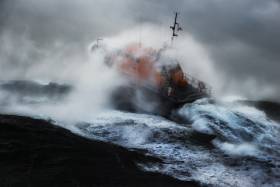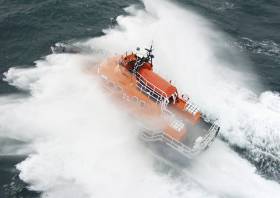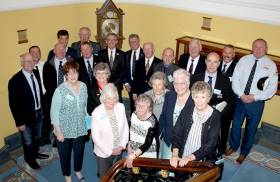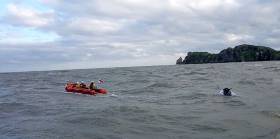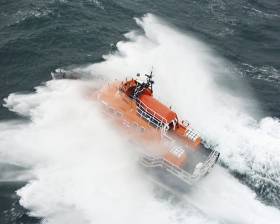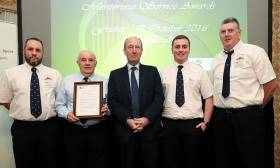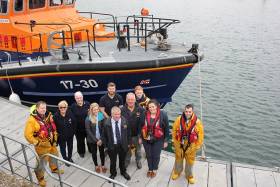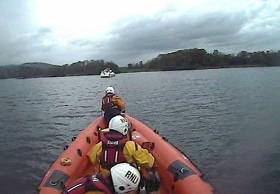Displaying items by tag: Lifeboat
RNLI & Irish Coast Guard Urge Public to ‘Respect the Water’ As Poor Weather Hits the Coast
The Irish Coast Guard and the RNLI are urging everyone to ‘Be Aware’ and ‘Respect the Water’ in the wake of recent warnings of poor weather hitting the Irish coast. While severe storms and flooding are highlighted nationally, people can be caught out very quickly with many accidents occurring due to strong winds, spring tides and heavy rainfall.
During times of bad weather the message from the RNLI and the Irish Coast Guard is to stay away from the water, give waves a wide berth, and be aware that in bad weather unexpected swells can easily catch people out. Even if the water itself looks calm, waves and tides can be very powerful and pull you off your feet.
Both organisations are advising that if you find yourself in the water unexpectedly, relax and float on your back to catch your breath and try to grab hold of something to keep you afloat. The initial shock of being in cold water can cause a person to gasp and panic. These initial effects of cold water pass in less than a minute, so don’t try to swim straight away. Keep calm, call for help, or swim for safety if you are able.
If you see someone in the water, call 999/112 and ask for the Coast Guard. If you have something that floats or that they can hold on to, throw it to them. Avoid going into the water yourself – many people drown trying to save others.
Gareth Morrison, RNLI Community Lifesaving Delivery Manager says: ‘Irish weather can be unpredictable at the best of times and our lifeboat crews have answered many call outs where people have been caught out by the weather unexpectedly taking a turn for the worse. We urge everyone to respect the water at all times and to keep safe and remind people not to underestimate the distance waves can travel up the beach or harbour wall. Although it can be tempting to get close, it isn’t worth risking your life to take photos or to dodge waves.’
Gareth continued: ‘If you plan on going out walking after a storm or high winds, be wary. Storms and high winds can change our landscape through coastal erosion so pay attention to warning signs, and don’t leave designated paths to look over the edge of clifftops.’
Gerard O’Flynn, Irish Coast Guard Operations Manager added: ‘For anybody planning on walking close to the shore, be it on a beach, cliff, public walkway or harbour facility is; Stay Back, Stay High, Stay Dry.’
Recruitment Opens for RNLI’s Best Summer Jobs
Recruitment has opened in Northern Ireland for this summer’s crop of beach lifeguards and face to face fundraisers. Both roles are essential in supporting the RNLI’s aim to keep people safe and prevent tragedies around the North Coast and in County Down.
Successful applicants for beach lifeguarding will receive world class training in search and rescue, lifesaving and casualty care techniques, as well as boosting their CV’s with invaluable skills that will wow future employers.
Recruits will also be trained in using the latest lifesaving equipment including rescue boards, rescue tubes and defibrillators.
Mike Grocott, Area Lifesaving Manager said: ‘I think working as a lifeguard has got to be one of the RNLI’s best summer jobs. Of course it’s incredible to be able to call the beach your office but far more importantly than that, you are there to make sure the public enjoy it in the safest possible way.
‘But make no mistake. This is a demanding job requiring commitment, skill and a clear head. We want people with the courage, determination and the ability to draw on their training and make the right decision if someone’s life is in danger.’
‘We are now also recruiting for face to face fundraisers, who work alongside our lifeguards on the beaches on the north coast and in County Down during the summer to provide people with important safety advice. They also have a key role in raising money for the charity so that it can continue providing a lifesaving service.’
Applicants will need to be a dynamic and positive ambassador for the charity, actively engaging with communities and inspiring support for our work to prevent the loss of life on the water.
Speaking of the face to face fundraising role, Mr Grocott added:
‘A good fundraiser generally has to be friendly and relaxed, but also energetic, able to talk to anyone and have fun and be passionate about what they do.
‘We will provide quality training which will make sure you feel confident and capable by the time summer begins. You’ll be developing new skills, having fun and working at the beach, this has to be one of RNLI’s best summer jobs.’
Arranmore RNLI Rescues Four Fishermen After 70ft Boat Gets into Difficulty off Donegal coast
Arranmore RNLI rescued four fishermen this morning after their 70ft boat got into difficulty off the Donegal coast.
The crew of the vessel which was travelling from Greencastle to Killybegs, raised the alarm before 7am after the boat developed steering problems some six nautical miles from Killybegs.
The all-weather lifeboat under Coxswain Jimmy Early launched at 7am and made its way to the scene which was approximately an hour and a half’s journey from Arranmore.
Once on scene, the volunteer lifeboat crew put a rope onboard the boat and worked with the fishermen to set up a tow line. However, due to a swell up to a metre and a half and south to south westerly Force 6-7 winds, the tow rope broke following set up. Once it was re-established, the lifeboat proceeded at slow speed due to the size of the fishing vessel, and made its way to Killybegs where it arrived with the vessel in tow at 11am.
Speaking following the call out, Tony Ward, Arranmore RNLI Lifeboat Operations Manager said: ‘The fishermen did the right thing this morning and called for assistance when they started to encounter difficulties. Weather conditions made the tow challenging but using their skills and training, our lifeboat crew were able to get the line re-established and bring the men safely to shore.’
RNLI Honours 21 Volunteers at Annual Awards Ceremony
RNLI volunteers have been honoured at the charity’s annual presentation of awards in Northern Ireland.
The event which was staged at the Belfast Harbour Commissioner’s Office on Friday night (21 October) honoured 21 awardees recognising their dedication and commitment to volunteering over long periods of time in a bid to raise funds and awareness and to help save lives at sea.
The ceremony was opened by Christopher Brooke, a member of the RNLI Council of Ireland. Mr Brooke welcomed the awardees and their families before introducing the guest speaker, outgoing RNLI Chairman Charles Hunter-Pease.
The awards included eight Gold Badges, four Bar to Gold badges, one supporter award, two Honorary Life Governorships and six long service awards.
The eight gold badge awards which recognise those who have dedicated many years to supporting the RNLI, were awarded to Sean Boyle and James Shovlin from The Rosses Branch in County Donegal, Rodney Byrne and Dorothy Weeks from the Portrush Lifeboat Management Group, Patrick Carter and Martin Reilly from the Sligo Bay Branch, Paddy McLaughlin from the Red Bay Branch in Cushendall and Lillian Stewart from the Larne Branch.
The Adelphi Hotel in Portrush was recognised with a supporter award.
There were four Bar to Gold badges, one of which was awarded posthumously to John Charleton from the Kilkeel Branch. Lynda Davidson from the Donaghadee Fundraising Branch, Margaret Nicholson from the Kilkeel Branch and Aileen Smyth from the Donaghadee Ladies’ Guild were also awarded.
The Honorary Life Governorship awards went to Eveleigh Brownlow from Portaferry and District Guild and Elenore Huston from the Coleraine/Castlerock Branch.
The long service awards in recognition of 20 years volunteering commitment went to Jeffrey Bell from Larne RNLI, Gregory McDaid from Lough Swilly RNLI, Raymond Newell from Kilkeel RNLI and Simon Rogers from Portaferry RNLI. Morrris McBride from Kilkeel RNLI and Shane McNamara from Donaghadee RNLI were recognised with a 30 year Bar to Long Service badge.
Speaking at the ceremony, Mr Hunter-Pease said there were a range of differing reasons why people volunteered for the RNLI: ‘There are the friendships forged through a common lifesaving aim. The thrill of seeing visitors enjoying your carefully planned events. The weight of a heavy bucket after a hard day’s collecting. And, yes many are motivated to volunteer for us by the pain of losing a loved one to the sea. They have converted that loss into a determination to make a difference to the lives of others.’
He said it was truly humbling to think of the collective years’ experience and care that was in the room: ‘To everyone one of you receiving an award – whether your service has been at sea or ashore – wear it with pride. It is the mark of someone very special, selflessly dedicated to the lives of others.’
Before presenting the awards, Mr Hunter-Pease said the RNLI had made an extraordinary difference to people’s lives in 2015. Volunteers from Northern Ireland’s nine lifeboat stations rescued 279 people and saved 11 lives. The lifeguards on 11 beaches on the Causeway Coast and in County Down rescued 11 people and saved one person’s life.
Howth RNLI Rescues Man From Sea after Jet Ski Gets into Difficulty
Howth RNLI rescued a man who got into difficulty on a jet ski this afternoon and ended up in the water east of Ireland’s Eye.
The volunteer lifeboat crew was requested to launch both their inshore and all-weather lifeboats at 3.35pm following reports that a man was missing in the sea after his jet ski developed engine difficulties.
The alarm had been raised by a companion of the casualty’s who had come ashore on his own jet ski.
The two men had left Howth harbour earlier in the day before one of their jet skis encountered problems.
The lifeboats quickly travelled to the reported area between Balscadden and Ireland’s Eye and commenced a search.
Weather conditions at the time were described as good with clear visibility. However, the sea was quite rough with strong easterly winds generating large breaking waves in the vicinity of Ireland’s Eye.
As Afloat.ie reported earlier, the Irish Coast Guard helicopter Rescue 116 was also tasked to the search. Using its onboard search equipment, the helicopter quickly located the casualty who had drifted quite a distance from his original location.
Following this communication from the Coast Guard helicopter, the all-weather lifeboat proceeded to the scene and rescued the casualty who was found clinging to the jet ski. He had been in the water for approximately 30 minutes. Once onboard the lifeboat, the crew began to administer casualty care to man who was extremely cold.
Arriving back at Howth Lifeboat Station, the man was transferred from the lifeboat into a waiting ambulance where he was treated for hypothermia.
The inshore lifeboat meanwhile took the stricken jet ski in tow and returned it to the safety of Howth Harbour.
Speaking following the call out, Colm Newport, Howth RNLI Lifeboat Operations Manager said: ‘Time was of the essence this afternoon as the casualty was in the water for some time. Team work was at the centre of this call out and with thanks to our colleagues in the Irish Coast Guard who located the casualty once onscene, we were able to rescue the man and bring him ashore. We would like to wish both him and his companion well following their ordeal.’
Canadian Yacht with Two Onboard Rescued By Arranmore RNLI
Arranmore RNLI in County Donegal launched in the early hours of this morning (Wednesday 19 October) to go the assistance of two sailors who got into difficulty at St John’s Point.
The volunteer lifeboat crew was requested to launch their all-weather lifeboat at 4.15am at the request of the Irish Coast Guard following a report that a Canadian 45ft yacht with two men onboard had ran aground at St John’s Point.
The lifeboat under Coxswain Lee Early and with six crew onboard launched and made its way to the scene.
Killybegs Coast Guard unit was also tasked.
Weather conditions at the time were described as blowing a Force 4-5 north westerly wind with a two metre swell.
Once on scene at 6.20am, the lifeboat crew observed that the vessel was right up on the reefs making it difficult for the Coast Guard’s inshore boat and the RNLI’s all-weather lifeboat to get close to the casualties. The yacht had also begun to take on water. It was at this point the Irish Coast Guard helicopter Rescue 118 from Sligo was also tasked with the decision made to airlift the sailors to safety.
Speaking following the call out, Arranmore RNLI mechanic Philip McCauley said: ‘This was a challenging call out for ourselves and our colleagues in the Coast Guard this morning due to where the vessel had ran aground so close to the rocks. We were able to assist the helicopter with providing extra light in the darkness as it winched the sailors to safety. We would like to wish them both well following their ordeal.’
Castletownbere RNLI Presented with National Marine Gallantry and Meritorious Service Award
The volunteer lifeboat crew from Castletownbere RNLI has been awarded a Marine Ministerial Letter of Appreciation for Meritorious Service.
The award in recognition of the crew’s ability to locate and save a life in challenging weather conditions was presented by the Minister for Transport, Tourism & Sport Shane Ross, T.D. at the National Marine Gallantry and Meritorious Service Awards 2016 at a ceremony in Farmleigh House in the Phoenix Park on Friday evening (14 October).
Castletownbere RNLI was represented at the awards by Lifeboat Operations Manager Tony O’Sullivan, Coxswain Brian O’Driscoll and crew members John Paul Downey and Kyle Cronin.
The call out for which the lifeboat was awarded happened when the Castletownbere lifeboat, Annette Hutton, was launched early on Saturday morning 20 August. After 12 hours at sea in storm force conditions, the volunteer lifeboat crew rescued a lone sailor.
Valentia Coast Guard Radio had requested assistance to a yacht in difficulties 45 miles south of Mizen head in West Cork. The resceu was reported at the time by Afloat.ie here.
The eight-metre yacht, with one person on board, had left the Azores in early August and ran into difficulties the day previous. The sailor, in his sixties, had been in regular radio contact with Valentia Coast Guard radio until the morning when his VHF radio was washed overboard. He activated an EPIRB to identify his location, raise the alarm and seek help.
The lifeboat, under the command of Coxswain Brian O’Driscoll, was launched at 8am and located the casualty at 10.40am 50 miles south-west of Castletownbere. The Irish Coast Guard helicopter was also on scene.
Conditions were described as gusting Force 8/9 winds with a 30 foot swell. The yacht was taken under tow and the lifeboat proceeded slowly to Castletownbere in challenging sea conditions. Early into the tow lifeboat crew became concerned about the wellbeing of the sailor and crew managed to transfer him to the lifeboat. The lifeboat, with the damaged yacht in tow, returned to Castletownbere at 8.30pm having been at sea for 12 and a half hours.
Later that evening the sailor thanked the Castletownbere lifeboat and all involved for ‘saving his life’. He said: ‘only for the lifeboat, things would have ended up very badly today’.
The Castletownbere Coxswain and crew demonstrated skill, seamanship and endurance during what was a long and challenging day.
Speaking at the awards ceremony, Minister Ross praised the ‘courageous achievements and service of this group of brave Irish men and women who have faced crises and dug deep, offering their skills and in many cases placing themselves in danger in order that others might be safe on our waterways’.
Pausing to remember those who lost their lives at sea since the last set of Awards in 2014, Minister Ross spoke of the tragic death of volunteer Coast Guard Caitríona Lucas last month, describing her as ‘a courageous and heroic woman who made the ultimate sacrifice while in the service of others’.
The awards are to recognise outstanding acts of courage, heroism, skill and initiative in the context of marine emergency incidents. The scheme also recognises exceptional dedication to duty in the execution of Ireland’s marine emergency response.
A Marine Ministerial Letter of Appreciation may be awarded for meritorious service where outstanding dedication to duty over a career of service can be demonstrated, or for an act of particular meritorious dedication, showing skill and initiative, but which is not of an order for receipt of a Meritorious Service or Marine Gallantry medal.
The volunteer lifeboat crew from Kinsale RNLI and Lough Swilly RNLI in County Donegal were also awarded a Marine Ministerial Letter of Appreciation.
The National Marine Gallantry and Meritorious Service Awards Committee is chaired by Bryan Dobson of RTÉ.
UK Justice Minister Visits Portrush RNLI Volunteers
Claire Sugden, The Justice Minister called in on her local RNLI Lifeboat station at Portrush the weekend to pay tribute to the work they do on the North Coast.
The Minister was keen to meet all the volunteers including crew, fundraisers and the operations team. She met Des Austin, Cox and Robin Cardwell Lifeboat Operations Manager (LOM) in the lifeboat House firstly to hear about the work of the volunteers and the rigorous training they underwent in order to achieve the competencies to be able to save lives at sea. She then met Sharman Finlay Chair of the fundraising team and Dorothy Weeks, supervisor of the very successful Lifeboat Shop to hear about the importance of fundraising activities to support the volunteer crew.
The Minister then met the volunteer crew of the Inshore Lifeboat and then went on board the All-weather Boat to get a tour of the boat and then experienced a launch as the crew took her out of the bay so she could see for herself, what the crew experienced when they went out on a shout.
The team at the station were delighted to meet the Minister and to have the chance to explain first-hand the importance of the work they do and the training that goes on behind the scenes.
Robin Cardwell LOM said
‘We were delighted to welcome the Minister to her local station and to give her an opportunity to see for herself the operations of a busy lifeboat station. We were thrilled that we had the opportunity to see the ALB in action to have a chat with the volunteer crew, operations team and fundraisers’.
The Minister said in a statement
‘The RNLI provides an invaluable service in keeping the public safe around our coastline. The men and women who volunteer to answer emergency calls in all weathers have helped save countless lives and I commend them for their dedication and commitment.
“The RNLI aims to reduce drowning by 50%, across the UK and Ireland by 2024. Given the dedication and enthusiasm I have seen demonstrated by the Portrush crew, I am confident that they will succeed.”
Courtmacsherry RNLI Lifeboat Rescues 40–foot Sailing Sloop off Kinsale
The Courtmacsherry RNLI All Weather Lifeboat was called out at 12.30pm this afternoon to go to the aid of a 40–foot Sailing Sloop 'in trouble' eight miles off the Old Head of Kinsale in West Cork.
Coxswain Sean O'Farrell and a crew of six launched in response to the Mayday alert from Coastguard and reached the casuality at 1.10 pm. The casualty with two persons on board had lost power in deteriorating conditions at sea and one of the crew person on board the yacht was also reported unwell.
The lifeboat succeeded in transferring its tow rope in difficult conditions to the casualty which was on passage from England to West Cork.
The Lifeboat took the vessel in tow and is heading at low speed to Kinsale.
Conditions at sea this afternoon are very poor with strong winds force 7/8 with very heavy swells. Winds in the area are blowing 35–knots and increasing.
The estimated time of arrival in Kinsale is approx 2.45pm
The RNLI crew are Coxswain Sean O Farrell and volunteer crew members Tadgh McCarthy (Mechanic), Mark Gannon, Ciaran Hurley, Ken Cashman, Mark John Gannon and Dave Philips.
Lough Derg RNLI Lifeboat launched to assist four people after their 34ft–cruiser ran aground by the Scilly Islands on Lough Derg today. At 1.39pm, the lifeboat launched with helm Ger Egan, Lian Knight and Delia Ho on board. Winds was east-southeasterly, Force 3. Visibility was good.
The lifeboat located the vessel at the junction of Scariff Bay and Parker’s Point at 1.54pm. The four people on board were safe and unharmed and wearing their lifejackets. Once the lifeboat was satisfied the vessel was not holed, it was taken off the rocks and into safe water. The cruiser continued its onward journey once drives and rudder were found to be undamaged and in good working order.
Peter Kennedy, Deputy Launching Authority at Lough Derg RNLI Lifeboat, advises boat users to ‘to bring charts with you and know the areas close to shore and islands marked as un-navigatable, particularly as water levels are low in the lake at the moment’.
The lifeboat returned to Station and was ready for service again at 3pm.




























